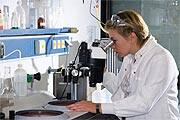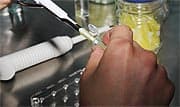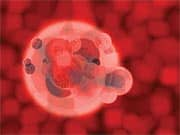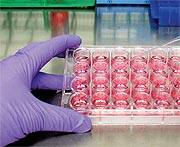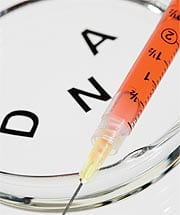Life Extension Magazine®
Just imagine making it to age 80, but you have not taken care of yourself. You thus suffer from severe degenerative disorders and have only a short time left to live. Instead of letting you die, a pioneering doctor implants a compound that lengthens the telomeres in your cells. Within 30 days, there is a systemic reversal of your age-related pathologies. Not only are you functioning like a much younger person, but you’re inquiring about birth control as your sexuality and fertility has also been restored. With your telomeres lengthened, you now can expect to live longer in better health, with the wisdom to avoid the bad habits that caused you to degenerate in the past. Most experts would argue that this is not possible. Yet a breakthrough discovery published in the November 28, 2010, online edition of the scientific journal Nature provides evidence that age reversal may become a reality.1 This study was conducted using telomerase-deficient mice with artificially shortened life spans. The purpose was to see if the consequences of accelerated aging could be reversed in animals suffering from advanced degenerative pathologies. The Breakthrough FindingsTelomeres are small units of DNA at the ends of our chromosomes. They are often compared to the plastic tips at the ends of shoelaces. As long as these tips (telomeres) remain intact, they keep the chromosomes from fraying and the genes inside from unraveling. As our cells divide normally, or in response to poor lifestyle choices, telomeres progressively shorten until cells become dysfunctional or die.2 When this happens, we grow older, become afflicted with the diseases of aging, and eventually die. This same degenerative effect occurs in our stem cells with aging, which makes them progressively unable to create healthy new cells.3
There is evidence that fish oil,4 vitamin D,5 carnosine,6-8 multivitamins,9 and healthy lifestyle choices10 may slow the rate of telomere shortening. This helps explain why people who take care of themselves and use the proper supplements enjoy such profound health benefits.2,11,12 What had not been proven, until now, is what happens if telomere length is substantially restored in already severely degenerated aged organisms.1 In the Nature study, prematurely aged mice developed degenerative problems such as shrinkage of organs, inability to produce sperm, and failure of their brains to produce new neurons or to maintain the structural integrity of the myelin sheath that protects existing neurons.1 As these degenerated mice neared death, researchers induced the re-activation of the enzyme telomerase. In response to telomerase re-activation, the telomeres at the end of their chromosomes lengthened.1 After only 30 days, there was a reversal of the degenerative changes in every system the researchers tested. The brains of the treated mice not only started growing new neurons, but began to thicken the protective myelin sheath surrounding existing neurons. As one of the researchers was quoted, they were able to “reverse neurodegeneration.” 1 The treated mice produced new viable sperm, their spleen atrophy and intestinal damage were reversed, and even their sense of smell was restored (indicating restored olfactory function in their brains).1 These mice initially were on the verge of dying, but went on to live a typical life span that was longer and healthier than could ever have been imagined considering the degenerative condition they were in at the beginning of the study. In humans, this would be like restoring the health and vigor of a sickly 80-year-old to that of a young adult! Circumventing the Harsh Realities of AgingIn the Nature study, DNA was damaged and could no longer emit signals to maintain cellular function or structure. Repair mechanisms collapsed, stem cells were compromised, and marked tissue atrophy occurred (such as brain shrinkage) along with functional impairment of organ systems.1
The significance of the Nature study is that it tested the effects of telomere lengthening in an animal model analogous in many ways to disabled elderly humans. (There were also differences in this mouse model compared to aged humans.) It is known from human cell culture studies that restoring telomere length results in unlimited cell division potential.13-15 What has not yet been demonstrated is the effect of telomere lengthening in normally aged animals with severe tissue degeneration. In this landmark study by Harvard-affiliated researchers, aging-accelerated mice whose telomeres were lengthened demonstrated rapid reversal of degenerative pathologies. While this is not the same as normally aged animals, it is an unprecedented demonstration of systemic age-reversal in a whole animal (in vivo) model. In this study, the aged mice with lengthened telomeres displayed new brain cell growth, restored sexual function and fertility, regeneration in every tissue examined, and a dramatically longer life span.1 The authors of the Nature study summarized their results by stating: “In conclusion, this unprecedented reversal of age-related decline in the central nervous system and other organs vital to adult mammalian health justify exploration of telomere rejuvenation strategies for age-associated diseases, particularly those driven by accumulating genotoxic stress.” 1 There are scientific advances that forever alter the course of human history. This may be one of these advances. As you will read next, Life Extension® is not going to stand still and rely on others to carry forth this critically important rejuvenation research. Age Reversal Can No Longer Be Ridiculed
Since the inception of the Life Extension Foundation four decades ago, we have endured harsh criticism from mainstream media and persecution by government agencies over our unwavering prediction that it will someday be possible to make older people young again. Just last year, research we funded succeeded for the first time in reversing the aging of human cells in the laboratory—including restoring telomere length in some instances. The scientists transported aged human cells back in time to their original embryonic state, enabling them to differentiate into any cell the body might need to self-regenerate. This age-reversal study we funded was published in the peer-reviewed journal Regenerative Medicine.16 The latest study published in Nature demonstrates that it is possible to take mammals in a severely degenerated condition and systemically reverse aging pathologies using only one mechanism, i.e. telomere lengthening. Life Extension Provides $2 Million for New Age-Reversal ProjectBased on our analysis of the current state of the art, we believe there are more effective methods to restore telomere length and reverse aging processes. In December 2010, the Life Extension Foundation provided $2 million in funding to a company called ReCyte Therapeutics (a subsidiary of BioTime, Inc.) for a new series of studies.17 The first will be on a group of mice that will utilize several cell rejuvenation mechanisms (including telomere lengthening) in a real-world model of aging. The initial goal of this research is to rejuvenate the vascular systems of these mice in a way that protects them against heart attack and stroke. The research will also be aimed at restoring youthful bone marrow function to reverse immune senescence, thus conferring protection against cancer, infectious disease, and autoimmune disorders.18-24 If these age-reversing effects can be documented in this mouse model and other biological systems, our research funding will then be used to attempt to develop authentic rejuvenation therapies in humans. |
Seeking to Vastly Accelerate Aging ResearchWe live in a fascinating era. Throughout history there were no validated methods to slow human aging, let alone reverse it. Today, scientists are meticulously investigating methods to enable our aging bodies to grow younger. If they succeed, then we might be the last generation to succumb to aging and the horrific diseases that accompany it. Long before the Nature study was published on November 28, 2010, I brought up a concept while meeting with scientists at a medical conference in December 2008.25 Everyone acknowledged that potential advances might enable us to reverse the aging process we are all suffering. The problem is that no coordinated plan existed amongst the various scientific disciplines to collectively harness this technology into a near-term reality. I proposed that we emulate what the United States did during World War II to rapidly develop the atomic bomb. I reasoned that if we instill a sense of confidence and urgency, we can collectively implement a “Manhattan Project” aimed at finding ways to reverse the festering aging process. Several volunteers followed up on my suggestion and put together a “Longevity Summit” that consisted of some of the world’s top anti-aging researchers. This longevity summit titled The Manhattan Beach Project was held November 13–15, 2009, in Manhattan Beach, CA.26 The expenses were high because we had to fly gerontology experts in from around the world and cover hotel fees and video recording. The Life Extension Foundation funded the entire cost, which amounted to around $60,000. The first two days of this summit featured presentations by researchers who revealed their scientific roadmap for initiating and achieving age reversal. Some of these scientists had been quietly developing their technologies for many years. The last day was a roundtable discussion among the wealthy attendees, the scientists, and some very creative minds. The purpose of this brainstorm session was to develop plans to fund these anti-aging research initiatives that our lives so heavily depend on. The following consensus was reached:
A New “Age-Reversal” InitiativeThe first step in implementing the Manhattan Beach Project was to assemble a knowledgeable and experienced Board of Directors to assure that the new company would be competently managed.
The next challenge was lining up the initial seed financing to get this company off the ground. Initially, $2 million was raised, of which the Life Extension Foundation provided $500,000. The primary motivation for people to be involved with this company is that the research it supports could lead to breakthroughs in the control of human aging that could enable them to live much longer. What I hope will be different with this company than any other are the expectations of these people. While there is a chance that the development of patented anti-aging therapies could yield considerable profits, that was not the main reason we thought individuals might participate. From the perspective of most Life Extension members, the development of validated methods that would enable humans to grow biologically younger is far more valuable than all the money in the world. The company is set up to assist, both financially and technologically, companies that are engaged in research that may lead to the control of human aging. Not all of these age-reversal initiatives will pan out. But if just one led to the development of a validated method to reverse the course of aging, then every participant (and mankind itself) would benefit. Age Reversal Was Not Thought PossibleWhen Life Extension was founded, most people did not believe that reversing human aging could ever happen. We proved them wrong last year by showing that at least at the cellular level, it is possible to re-program genes to prompt human cells to go back in time. This discovery was announced in the June 2010 issue of Life Extension Magazine.27
If one looks at the rapid technology advances we enjoy today, the probability of conquering aging can be easily analogized. Just think of the progress that has been made in other fields:
One reason we are confident that age reversal is possible in our lifetime is the law of accelerating returns, which means that as scientists reach higher technological milestones, the accumulated knowledge base can be used to rapidly move up the scientific ladder. At the Manhattan Beach Project summit in November 2009, a number of scenarios for slowing or reversing aging were presented by eminent scientific authorities. The consensus amongst the participants was that it may be possible to cure aging in our lifetime. This prediction was made before the landmark aging-reversal study was published in Nature just one year later (in November 2010).
We reasoned that if we could move up the next big anti-aging breakthrough by even a few years, this will mean the difference between life and death to many of those reading this article. That is why we view this matter with such a sense of urgency. Where We Stand TodayThe challenge we face is turning around public opinion to make aging research the number one priority. We need to overcome the denial about personal extinction that plagues the vast majority of the population. Once this is accomplished, I am certain the collective efforts of the scientific community will deal with aging as efficiently as hand-held computers function today. Life Extension is currently evaluating several programs aimed at substantially increasing funding to scientists involved in age-reversal research. Your support through membership renewals and product purchases enables us to finance ongoing scientific projects while laying the groundwork for exponential expansion of this research in the not-too-distant future. For longer life,
William Faloon
| ||||||
| References | ||||||
| 1.Jaskelioff M, Muller FL, Paik JH, et al. Telomerase reactivation reverses tissue degeneration in aged telomerase-deficient mice. Nature. 2011 Jan 6;469(7328):102-6. 2.von Zglinicki T. Oxidative stress shortens telomeres. Trends Biochem Sci. 2002 Jul;27(7):339-44. 3.Marión RM, Blasco MA. Telomeres and telomerase in adult stem cells and pluripotent embryonic stem cells. Adv Exp Med Biol. 2010;695:118-31. 4.Farzaneh-Far R, Lin J, Epel ES, Harris WS, Blackburn EH, Whooley MA. Association of marine omega-3 fatty acid levels with telomeric aging in patients with coronary heart disease. JAMA. 2010 Jan 20;303(3):250-7. 5.Richards JB, Valdes AM, Gardner JP, et al. Higher serum vitamin D concentrations are associated with longer leukocyte telomere length in women. Am J Clin Nutr. 2007 Nov;86(5):1420-5. 6.Babizhayev MA, Yegorov YE. Telomere attrition in lens epithelial cells - a target for N-acetylcarnosine therapy. Front Biosci. 2010 Jun 1;15:934-56. 7.Shao L, Li QH, Tan Z. L-carnosine reduces telomere damage and shortening rate in cultured normal fibroblasts. Biochem Biophys Res Commun. 2004 Nov 12;324(2):931-6. 8.Wang AM, Ma C, Xie ZH, Shen F. Use of carnosine as a natural anti-senescence drug for human beings. Biochemistry (Mosc). 2000 Jul;65(7):869-71. 9.Xu Q. Multivitamin use and telomere length in women. Am J Clin Nutr. 2009 Jun;89(6):1857-63. 10.Puterman E, Lin J, Blackburn E, O’Donovan A, Adler N, Epel E. The power of exercise: buffering the effect of chronic stress on telomere length. PLoS One. 2010 May 26;5(5):e10837. 11.Richter T, von Zglinicki T. A continuous correlation between oxidative stress and telomere shortening in fibroblasts. Exp Gerontol. 2007 Nov;42(11):1039-42. 12.Tanaka Y, Moritoh Y, Miwa N. Age-dependent telomere-shortening is repressed by phosphorylated alpha-tocopherol together with cellular longevity and intracellular oxidative-stress reduction in human brain microvascular endotheliocytes. J Cell Biochem. 2007 Oct 15;102(3):689-703. 13.Condon J, Yin S, Mayhew B, et al. Telomerase immortalization of human myometrial cells. Biol Reprod. 2002 Aug;67(2):506-14. 14.Londoño-Vallejo JA, DerSarkissian H, Cazes L, Thomas G. Differences in telomere length between homologous chromosomes in humans. Nucleic Acids Res. 2001 Aug 1;29(15):3164-71. 15.Allsopp RC, Vaziri H, Patterson C et al. Telomere length predicts replicative capacity of human fibroblasts. Proc Natl Acad Sci U S A. 1992 Nov 1; 89(21):10114-8. 16.Vaziri H, Chapman KB, Guigova A, et al. Spontaneous reversal of the developmental aging of normal human cells following transcriptional reprogramming. Regen Med. 2010 May;5(3):345-63. 17.Available at: http://www.lifeextension.com/featured-articles/Life-Extension-Provides-2-million-dollars-for-Age-Reversal-Study.htm. Accessed January 12, 2011. 18.Bhattacharjee RN, Banerjee B, Akira S, Hande MP. Telomere-mediated chromosomal instability triggers TLR4 induced inflammation and death in mice. PLoS One. 2010 Jul 29;5(7):e11873. 19.Armanios M, Alder JK, Parry EM, Karim B, Strong MA, Greider CW. Short telomeres are sufficient to cause the degenerative defects associated with aging. Am J Hum Genet. 2009 Dec;85(6):823-32. 20.Ilmonen P, Kotrschal A, Penn DJ. Telomere attrition due to infection. PLoS One. 2008 May 14;3(5):e2143. 21.Starr JM, McGurn B, Harris SE, Whalley LJ, Deary IJ, Shiels PG. Association between telomere length and heart disease in a narrow age cohort of older people. Exp Gerontol. 2007 Jun;42(6):571-3. 22.Unryn BM, Hao D, Glück S, Riabowol KT. Acceleration of telomere loss by chemotherapy is greater in older patients with locally advanced head and neck cancer. Clin Cancer Res. 2006 Nov 1;12(21):6345-50. 23.Sastry PS, Parikh P. The earlier age of onset of malignancy in developing world is related to overall infection burden and could be due to the effect on telomere length. Med Hypotheses. 2003 Apr;60(4):573-4. 24.Weng N. Interplay between telomere length and telomerase in human leukocyte differentiation and aging. J Leukoc Biol. 2001 Dec;70(6):861-7. 25.16th Annual International Congress on Anti-Aging Medicine & Regenerative Biomedical Technologies. Las Vegas, Nevada: The Venetian Resort, Hotel, and Casino; December 11-14, 2008. 26.Available at: http://www.maxlife.org/articles/2009/11/progress-for-immortality.asp. Accessed January 14, 2011. 27.Fahy GM, Kent S. Immortal Stem Cells for Anti-Aging Therapies: An Interview with Michael D. West, PhD. Life Extension Magazine®.2010 Jun;16(6): 26-32. 28.Ramagopalan SV, Heger A, Berlanga AJ, et al. A ChIP-seq-defined genome-wide map of vitamin D receptor binding: Associations with disease and evolution. Genome Res. 2010 Oct;20(10):1352-60. 29.John EM, Schwartz GG, Koo J, Van Den BD, Ingles SA. Sun exposure, vitamin D receptor gene polymorphisms, and risk of advanced prostate cancer. Cancer Res. 2005 Jun 15;65(12):5470-9. 30.Welsh J, Wietzke JA, Zinser GM, Byrne B, Smith K, Narvaez CJ. Vitamin D-3 receptor as a target for breast cancer prevention. J Nutr. 2003 Jul;133(7 Suppl):2425S-2433S. 31.Ross TK, Darwish HM, Moss VE, DeLuca HF. Vitamin D-influenced gene expression via a ligand-independent, receptor-DNA complex intermediate. Proc Natl Acad Sci U S A. 1993 Oct 15;90(20):9257-60. 32.Barger JL, Kayo T, Vann JM, et al. A low dose of dietary resveratrol partially mimics caloric restriction and retards aging parameters in mice. PLoS One. 2008 Jun 4;3(6):e2264. 33.Jones SB, DePrimo SE, Whitfield ML, Brooks JD. Resveratrol-induced geneexpression profiles in human prostate cancer cells. Cancer Epidemiol Biomarkers Prev. 2005 Mar;14(3):596-604. 34.Serrero G, Lu R. Effect of resveratrol on the expression of autocrine growth modulators in human breast cancer cells. Antioxid Redox Signal. 2001 Dec;3(6):969-79. |




